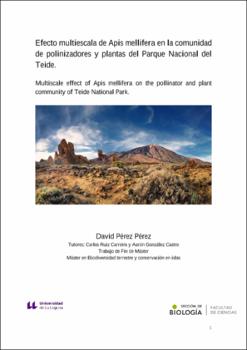Efecto multiescala de Apis mellifera en la comunidad de polinizadores y plantas del Parque Nacional del Teide
Autor
Pérez Pérez, DavidFecha
2021Resumen
La abeja de la miel europea (Apis mellifera) es la especie de abeja más extendida por el
mundo debido a su enorme uso como especie ganadera en la apicultura. A pesar de ser de
gran importancia para la polinización de una gran variedad de plantas silvestres y de
cultivos, numerosos estudios han resaltado el impacto negativo de esta especie sobre los
polinizadores silvestres y plantas debido a la intensificación de la apicultura en el último
medio siglo. En Canarias, y más concretamente en el Parque Nacional del Teide, diversos
estudios han evaluado el impacto de A. mellifera en el ecosistema de la alta montaña de
Tenerife, demostrando un impacto negativo en la comunidad de polinizadores silvestres.
Nuestro trabajo se centra en evaluar el impacto de los asentamientos apícolas del Llano
de Maja, en el sector nororiental del Parque Nacional del Teide, sobre la estructura de la
comunidad de polinizadores silvestres, así como el éxito reproductivo de las abejas
silvestres durante la floración del matorral de alta montaña de Tenerife. Los resultados
obtenidos sugieren que no hay un impacto visible sobre la comunidad de polinizadores
silvestres, estando más determinada por la variación espacial y temporal de los recursos
florales. Sin embargo, sí se aprecian efectos, directos e indirectos, sobre el éxito
reproductivo de dos abejas silvestres evaluadas en este trabajo: Osmia submicans e
Hylaeus canariensis. The European honey bee (Apis mellifera) is the most widespread species of bee in the
world due to its enormous use as a livestock species in beekeeping. Despite being of great
importance for the pollination of a wide variety of wild and crop plants, numerous studies
have highlighted the negative impact of this species on wild pollinators and plants due to
the intensification of beekeeping in the last half century. In the Canary Islands, and more
specifically in the Teide National Park, various studies have evaluated the impact of A.
mellifera on the high mountain ecosystem of Tenerife, demonstrating a negative impact
on the community of wild pollinators. Our work focuses on evaluating the impact of the
beekeeping settlements of Llano de Maja, in the northeastern sector of the Teide National
Park, on the structure of community of wild pollinators, as well as the reproductive
success of wild bees during the flowering of the high mountain scrub of Tenerife. The
results obtained suggest that there is no visible impact on the community of wild
pollinators, being more determined by the spatial and temporal variation of flower
resources. However, there are direct and indirect effects on the reproductive fitness of
two wild bees evaluated in this work: Osmia submicans and Hylaeus canariensis.




